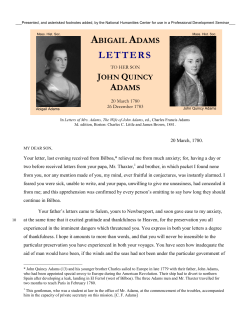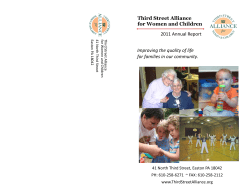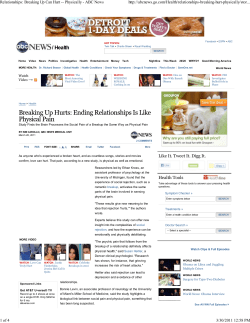
Alliance for Building Community Collaborating to mobilize resources
Alliance for Building Community Collaborating to mobilize resources For a healthy Adams County Alliance for Building Community (ABC) is a community partnership of individuals and groups working to improve the quality of life for all residents of Adams County. We invite the citizens of Adams County to join the Alliance for Building Community to help identify priorities, find solutions and improve lives. Our Vision: We are committed to creating cooperative community partnerships in order to build the quality of life for every citizen of Adams County. Attention all Impact Team Members! Impact Team Update Wednesday, April 13, 2005 10 am—12 noon Location to be Announced Our Mission: To facilitate an ongoing community forum where participants mobilize community strengths and resources to address community needs. Plan to attend this meeting to review and discuss the Community Wellness report. Reserve your spot by contacting: abcadamscounty@yahoo.com, or laurie@unitedwayadamsco.org Alliance for Building Community Goals: • • • • • • • Bring people together Focus on priorities Tackle root causes Inspire action & encourage community support Participate in public policy decisions Research, create and test long term solutions Improve individual lives and our community Contact Information: Alliance for Building Community Services include: Cheryl Waterman United Way of Adams County 217-222-5020 cheryl@unitedwayadamsco.org Building Capacity Provide data, tools, and training for participants to make informed decisions, offer quality programs, and evaluate outcomes. Julie Shepard Adams County Health Dept PATCH 217-222-8440 jshepard@co.adams.il.us Carrie Edgar University of Illinois Extension 217-223-8380 cedgar@uiuc.edu of Adams C ounty, Inc. Facilitating Change Work with policy makers, businesses, organizations, community members and funders to make sure community outcomes and indicators are used in policy and planning processes. Measuring Success A comprehensive evaluation plan and data clearinghouse. ABC encourages evidence based programming and services that focus on delivering results and measuring outcomes. Results are reported to provide greater accountability to donors and the community. Community Wellness Report A printed report on the community outcomes and indicators targeting community-wide awareness of the issues Community Outcomes Outcomes are the qualities that Adams county residents say matter the most. Indicators are measures of these outcomes. These outcomes and indicators have been identified and chosen by over 100 citizens participating in four impact teams. The outcomes and indicators serve as reminders and rallying points for community-minded individuals, groups, policy makers, and organizations to focus their efforts to make a measurable difference. A. Residents live in a state of economic well-being Residents living in poverty Unemployment Median hourly wage/income Underemployment Jobs Available B. Residents possess the skills to be successful in school and work High School dropout rate HS completion rate/GED Rate School Attendance/Truancy rates Test scores on standardized tests Public school expenditures per pupil College/job training enrollment Resident education levels C. Community Infrastructure supports health and economic well-being Youth have involved, caring adult Youth participate in activities Access to public transportation Miles traveled to work Affordable licensed daycare Smoke free restaurants/workplaces Green space/trails Philanthropic dollars invested in community D. Appropriate and affordable housing Residents living independently Median household renter income Housing affordability index E. Access to health and social services Residents with health insurance Access to mental health services Residents not accessing healthcare due to cost F. Residents lead healthy lifestyles Leading causes of death Obesity rates Prenatal care Teen Pregnancy Immunization rates Youth death rates At risk behaviors G. Residents live in a safe environment Property/violent crime rates Perception of safety Child abuse School violence Response time for emergency services H. Residents are engaged civic participants Resident volunteer rates Voter turnout Organization/club membership Charitable giving See Community Wellness report for more information. Community Building Day (Adapted from Kelly Wilson’s article in the Quincy Herald-Whig on 1-13-05) On January 12th hundreds of Adams County residents came together to celebrate the work of the Alliance for Building Community. For nearly two years, leaders from 3 local organizations have worked to create the foundation for what they hope will be the initiative to address critical issues in Adams County. Community Building Day is a step to get all segments of the community involved. "The goal from the beginning was to take it to the community level. It's got to happen," said Cheryl Waterman, executive director of the United Way of Adams County. "This has to involve the whole community," Shepard said. "Agencies can't solve all the problems. Really, what makes a community work is when community members step up." More than 100 community volunteers already are involved in the initiative. "The next challenge is building the circle. Tyler Norris, served as keynote speaker and facilitator for Community Building Day. Norris is president of Community Initiatives in Boulder, Colo., and a nationally known expert in providing strategic consultation and support to community collaborations and health-care organizations. He has worked with more than 275 communities and health-care organizations to help initiate civic, health, education and social venture projects. On Wednesday, Norris spoke to over 200 community leaders during 3 meetings, highlighting the significance of the Alliance for Building Community initiative, explaining the value of a unified community vision and encouraging those in attendance to get involved in the next phase of the planning process. "There's an important transition that must occur. It can no longer be seen as an effort of these partnering organizations. It will have to become part of the infrastructure of this community," Norris said. "You need to ask, 'How can I be a full partner in this?'" During the past year the Alliance for Building Community had over 100 individuals participating on 4 community impact teams to identify outcomes and indicators as a way to measure the community's progress. Each team developed a logic model for their area of concern. The 4 areas included Nurturing Children and Youth, Fostering Health & Well-being, Strengthening Individuals & Families and Building Self Sufficiency. From the logic models a smaller committee has identified 8 community outcomes and approximately 42 indicators. The ability to measure outcomes, to prove that efforts are having a positive impact in the community, will guide several aspects of community work including funding, education, health care, government and economic development. “Community development ultimately is a driver of economic development," Norris said. "A healthy civic life creates a healthy economy, and I think that's what you're doing." Norris is impressed with the first phase of the Alliance for Building Community initiative and hopes the momentum continues on a broader level. "What's happened here in the last couple years is significant," he said. "What it comes down to now is community will. It's about leadership and how we build the civic infrastructure. It won't just happen with the existing organizations." Waterman, Shepard and Edgar are excited to see the response from community members and where the initiative will go. "The key now is getting out and letting people know this exists and determining how people can participate," Shepard said. "It's figuring out how we can all come together to help our community." How you can get involved Alliance for Building Community encourages individuals, businesses, organizations and policy makers to come together to explore these community issues and seek solutions. This can be done in several ways including discussion groups, adopting an outcome or indicator, volunteering, and more. The Short History of Alliance for Building Community Spring 2003 The United Way of Adams County Board reviewed and accepted the 2002 community assessment and recommendations. At this time they began a transition to focus on community impact which soon led to adopting a community impact model. Fall 2003 A desire to enhance community assessment, planning and evaluation processes in Adams County fostered the birth of ABC. Leaders from United Way of Adams County, University of Illinois Extension and the Adams County Health Department recognized each agency conducted community assessments and there were many similarities in the priorities identified. The 3 organizations felt that this obvious duplication of effort and expense could be reduced by a shared effort that will also strengthen assessment and planning functions. In addition to greater efficiency, an evaluation process will be developed to measure the results of programming implemented in the community – an element no partner can accomplish alone. Winter 03/04 Over 100 people from 60 organizations participated in training to refine their program goals and ability to measure and report results. The training was provided by The Medical Foundation funded by Marion Gardner Jackson Charitable Trust. 2004 Four impact teams came together consisting of over 100 citizens and representing 60 community organizations to develop community logic models in 4 broad areas: Nurturing Children and Youth, Building Self Sufficiency, Fostering Health and Well-being, and Strengthening Families and Individuals. These 4 logic models were then used to identify the community plan consisting of the 8 outcomes and indicators. December 2004 The Marion Gardner Jackson Charitable Trust awarded ABC a 3 year grant to continue the transition to focus on community impact and the development of a community model. January 2005 Community Building Day celebrated the work completed by ABC. Over 200 individuals representing a wide variety of community organizations and businesses viewed the community model and were invited to join ABC. Tyler Norris, a nationally known expert in providing strategic consultation and performance support to community collaborations, facilitated the day’s activities. Alliance for Building Community 300 Civic Center Plaza, Suite 260 Quincy, IL 62301 Non-Profit Org. U.S. Postage PAID Quincy, Illinois Permit No. 167 www.allianceforbuildingcommunity.org Alliance for Building Community is partially funded by the Marion Gardner Jackson Charitable Trust
© Copyright 2025





















